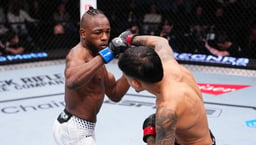
Issue 041
September 2008
A noticeable trend has developed among those fighters who have entered the Ultimate Fighting Championship (UFC) in the 15 months since the demise of Pride.
Akihiro Gono and Ryo Chonan are among those who now compete in a different weight class to the one they previously participated in. The pair have each lost the 13lbs needed to allow them to compete at welterweight in the USA, and both look much healthier for it.
The reason they have waited this long to make the move is that their former employer Pride had only four divisions, which resulted in a number of fighters being forced to compete outside of their optimum condition simply to fit in and earn a living.
Gono and Chonan had the choice between divisions of 183lb or 161lb if they wanted to receive the best possible sums from fighting in Japan. Attempting to reach the lower weight would have been impossible for both, so the decision to fight ‘heavy’ was effectively made for them. In North America, the 170lb division is perfectly suited for them, and for the first time the pair have the opportunity to face world-class competition on a level playing field.
Last year Gary Shaw of Elite XC made the decision to implement changes to the traditionally recognised ‘unified rules’ weight class structure. The reasoning offered was that he believed fighters were being forced to cut too much weight in order to fit into one of the existing categories, and that the new model was being introduced with the fighter’s safety in mind.
In reality the decision was taken for mainly financial reasons. The company had recently signed Nick Diaz, a welterweight in the UFC, but already had his training partner and good friend Jake Shields as the top dog in the 170lb division. With the California-resident unable to slim himself to lightweight (155lb) the 160lb class was devised almost entirely for the new arrival, and in turn allowed both men to fight for separate belts. The resulting re-shuffle that created 140lb and 150lb straps almost seemed like an afterthought.
But even with all the shuffling of numbers, Diaz’s inability to make the new weight for his recent fight against Mushin Corbbrey and Gina Carano’s constant battle with the scales has resulted in a number of high-profile bouts taking place at agreed limits outside of the traditional ranges, resulting in a general level of confusion among fans.
The UFC has also felt the strain, and the June main event of Thiago Alves vs Matt Hughes was made a catchweight contest when the Brazilian was unable to get anywhere near the standard welterweight limit. Having previously been banned for the use of a diuretic (a drug that makes it easier to cut a greater amount of water), the ‘Pitbull’ has always had issues. Hughes had previously fought Royce Gracie at 175lb and had remarked at the time how much better he felt having not needed to drain his body to the usual extent.
Clearly the weight class problem is one that needs addressing. The aim is simple – to create healthy gaps between divisions that are close enough to avoid scenarios like the above, but far enough apart so that the talent pool is not diluted to the point where title belts become uncompetitive.
The Association of Boxing Commissions (ABC) in North America recently sought to update the unified rules of MMA with this issue at the forefront of their thinking. After listening to advice from ex-UFC referee ‘Big’ John McCarthy they proposed a ten pound increase per weight class, from 135lbs to 205lbs, as well as a new 225lb and over division to separate the super heavyweights from the merely very-big ones.
UFC president Dana White has already said that his company will not adhere to the new guidelines and, with so many of the states in which they promote being absent from the discussions, ignoring them will not be a problem. Alas, we appear no closer to a resolution.
While I disagree with their ideas for heavier fighters, the ABC have got it spot on with regards to 185lb and below. By adding a division and allowing for 165lb and 175lb limits, the likes of Diaz, Diego Sanchez and the UK’s Dan Hardy would no longer have to choose between an uncomfortable cut to lightweight or be dwarfed by naturally larger fighters such as Alves, Jon Fitch and Georges St. Pierre.
MMA fans are quick to say
“We don’t want to turn into boxing”, but is this simply because they don’t want to deal with the initial shake-up that a change would cause?
Personally, I’d gladly ‘suffer’ a period of transition if the end result sees less catchweight contests and a greater number of bouts between fighters who aren’t being shoe-horned into a category that is unsuitable
and outdated.
...









